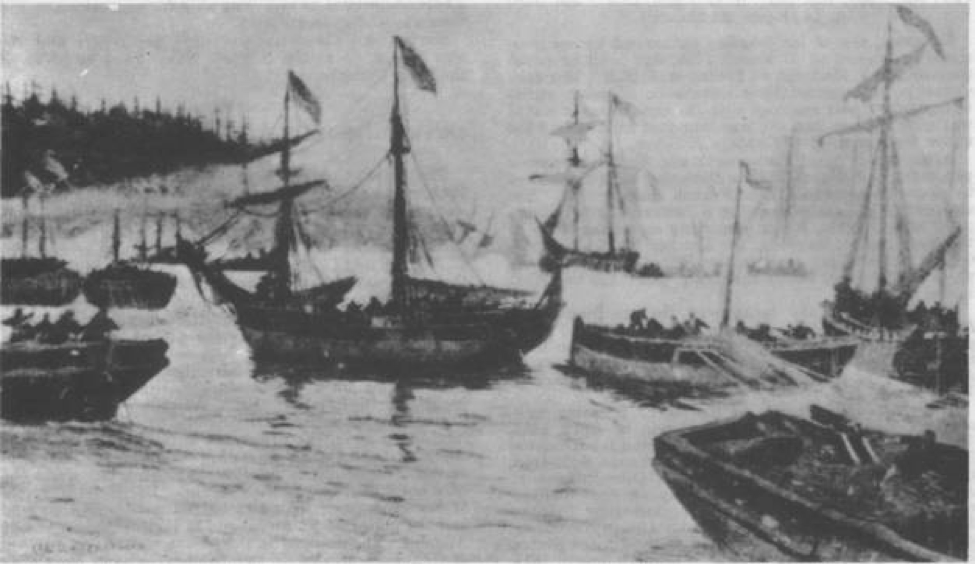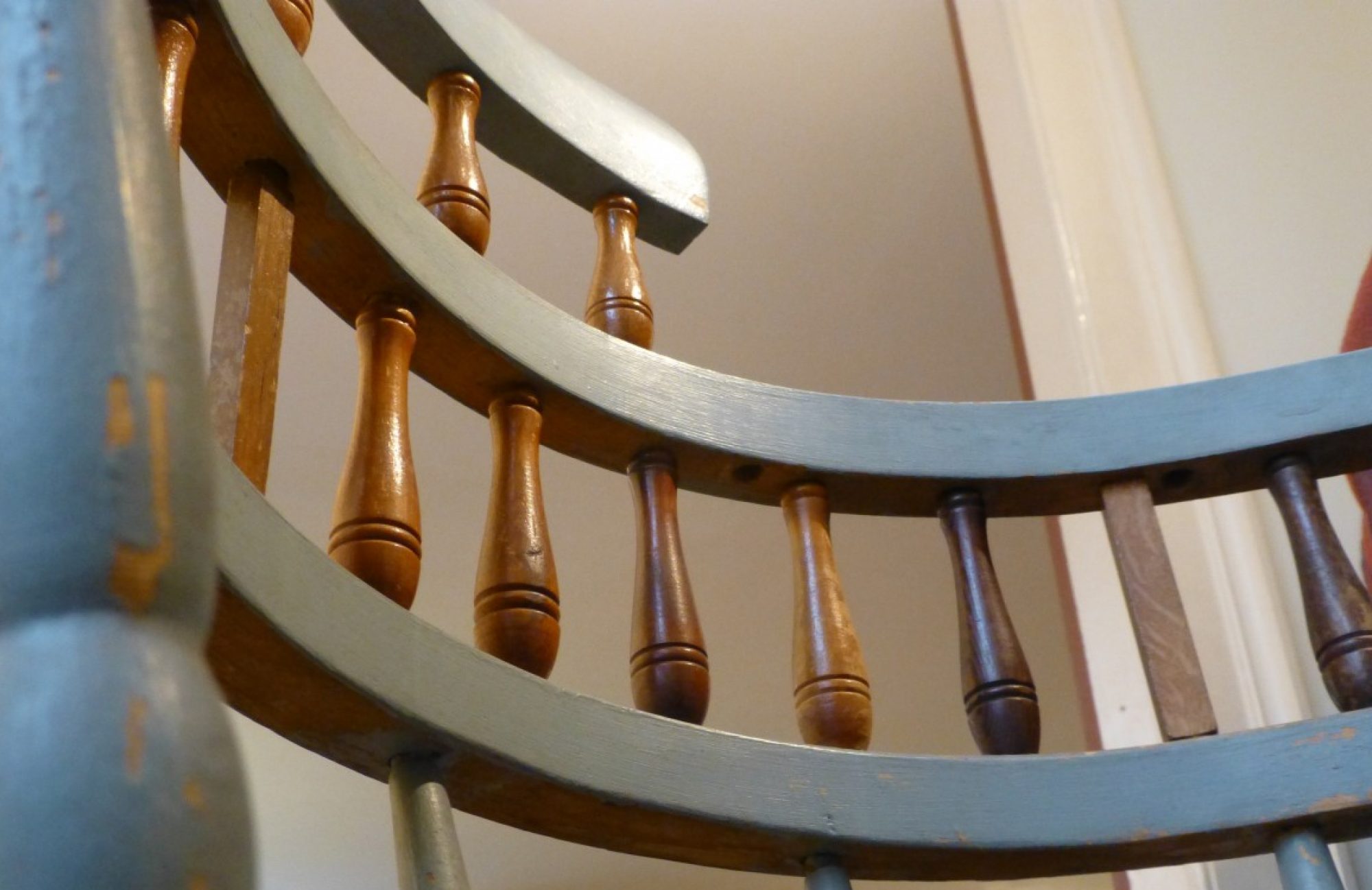The third spindle from the left on the bottom row of Henry Sheldon’s Relic Chair is made from wood taken from the USS Congress. There have been six US ships bearing the Congress name, but this wood is from the first.
In 1776, American forces suspected an “imminent evacuation” of Canada by American troops following unsuccessful operations in Quebec City, and Brigadier General Benedict Arnold, from his post in Canada, became aware that the British were preparing ships for an invasion on Lake Champlain.1 These factors led to the dispatch of thirty carpenters to Skenesborough, New York (today known as Whitehall), to build a fleet of ships under the command of General Philip Schuyler. This site provided access to much timber and had two sawmills and an iron forge to allow rapid construction. Schuyler delegated command of the project to Hermanus Schuyler (no relation). When the bases of the ships were finished, they were sent to Fort Ticonderoga for “masting and rigging.”2

The first ship from this run of production was launched on June 26, 1776. Philip Schuyler reported to George Washington that one ship could be produced every six days, his confidence boosted by an order for one hundred carpenters from Connecticut and Massachusetts. These carpenters were able to negotiate a very high salary and extensive rations in exchange for work from sunrise to sunset, apart from brief breaks for breakfast and dinner. Schuyler continued to optimize construction and request more men when needed, but in August of 1776 the process severely slowed, due to smallpox and malaria affecting many blacksmiths and carpenters.3 In addition, there were disciplinary issues among some of the carpenters, severely affecting morale.4 Despite these obstacles, the USS Congress was launched on September 1st, 1776. It was armed with six carriage guns and sixteen swivel guns, and manned by eighty sailors.

(Charles Randle, New England Armed Vessels in Valcure [sic] Bay, Lake Champlain [including Royal Savage, Revenge, Lee, Trumbull, Washington, Congress, Philadelphia, New York, Jersey, Connecticut, Providence, New Haven, Spitfire, Boston, and the Liberty] commanded by Benedict Arnold, 1776. Credit: Library and Archives Canada, Acc. No. 1996-82-2
On October 6th, the USS Congress joined Benedict Arnold’s fleet, and on October 11th, Arnold made the Congress his flagship.5 On that same day, fighting began with the approaching British fleet. By the end of the day, the Congress had been hit twelve times, seven of them “below the waterline”.6 The Americans suffered severe casualties and had to burn one of their ships, the Royal Savage, to avoid it being taken by the British.7 Arnold held a meeting aboard his flagship that evening, where he told his officers “there would be no surrender; they would make their escape during the night.”8 The American forces, led by the Trumbull, slipped between the British forces and the New York shoreline, making their way south. They were undetected, likely aided by distraction of the burning Royal Savage.9 By daybreak, the Americans were still in sight of the British fleet, but the winds prevented the British from catching up and allowed the Americans a quick stop for repairs.10 However, the next morning the winds changed, and the British were able to fire upon the Congress and the Washington, which was forced to surrender. The British turned their focus to the Congress alone, which sustained even more damage until the battle morphed into a “running chase.”11
To prevent British capture of his vessel, Arnold headed to Ferris Bay, an area he was familiar with. He ran his ship aground and burned it into the water.12 Dr. Robert Knox, who was present, claimed in a letter that Arnold burned “the wounded and sick” inside the vessels, though it could be that Arnold, in the interest of time, did not remove the dead bodies from the ship, which Knox mistakenly believed to be wounded.
The Naval History and Heritage Command states that though the Congress was destroyed and much of her crew killed, it played a role in delaying the British enough to make successful next year’s defense of Saratoga, New York, a “major victory” and “most powerful factor, in influencing France to throw her might, including the large French Navy, on the side of the struggling young republic.”13
According to his acquisition ledger, this spindle was given to Henry Sheldon by a “W. W. Swiney” in January of 1884 (likely William Wallace Swiney of Vergennes). The only known correspondence between these two is a short note written by Sheldon, regarding lending Swiney a series of books. However, Sheldon does address Swiney as “friend.” This suggests a continued amicable relationship between the two.

-Colin Flaherty ’20
Footnotes
1. John R. Bratten, The Gondola Philadelphia and the Battle of Lake Champlain (College Station: Texas A&M University Press, 2002), 18.
2. Ibid., 20.
3. Ibid., 34.
4. Ibid., 35.
5. Naval History and Heritage Command, “Congress I (Galley),” published June 30, 2015: https://www.history.navy.mil/research/histories/ship-histories/danfs/c/congress-i.html; Bratten, 57.
6. Bratten, 64.
7. Ibid., 65.
8. Ibid., 66.
9. Ibid.
10. Ibid., 67.
11. Ibid., 69.
12. Ibid.
13. Naval History and Heritage Command, “Congress I (Galley).”
Additional Readings
Art Cohn, “An Incident Not Known to History: Squire Ferris and Benedict Arnold at Ferris Bay, October 13, 1776,” Vermont History 55, no. 2 (Spring 1987): https://vermonthistory.org/journal/misc/FerrisBay.pdf


You must be logged in to post a comment.